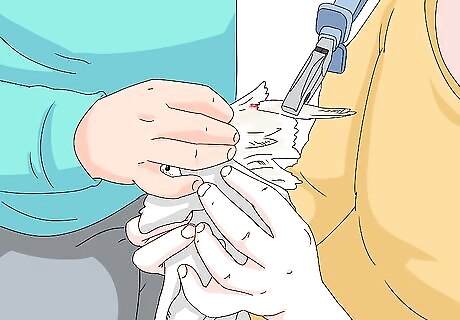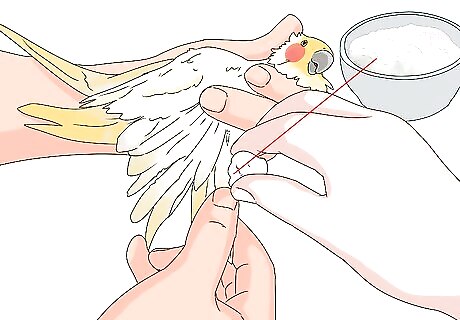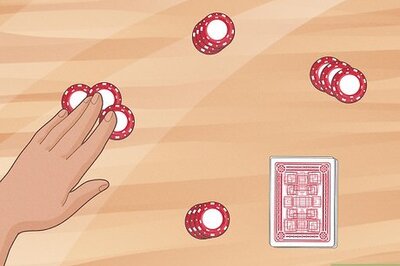
views
Treating a Broken Blood Feather

Act quickly. Anytime a bird has a broken blood feather, it can be life threatening. The bird can bleed out very quickly, so it is important to act fast in order to help it survive.

Wrap the cockatiel in a towel. To help restrain and calm the bird, you should wrap them in a towel. Cover the entire bird in the towel, except the part you are working on. Make sure the towel isn’t too tight around the bird, and keep a loose grip on it. Toweling the bird helps them safe and secure. Make sure you gently fold the wing you’re not working on against their body. If you don’t have a towel of the right size, you can use a sock or t-shirt.

Talk to your bird as you help it. Stay calm and talk to your bird in a calm, even voice as you help it. Birds can pick up on your stress, so it will not help the situation if you from become upset. Even though they can’t understand you, tell them calmly what you’re going to do to help them.

Have another person hold the bird. Once your bird is toweled, get someone else to hold the bird for you. Having another person hold the bird allows you to be able to concentrate on removing the delicate blood feather and gives you the use of both of your hands.

Remove the feather carefully with a pair of pliers. Removing feathers is very delicate work. You can accidentally break the bird’s bones or cause them more harm. Have someone hold your bird while you use a pair of pliers or hemostats to grip the feather. Get as close to the skin as possible and grab the feather shaft above the break. Secure the wing against the surface of your work area, and pull with a quick, firm yank. The end of the feather should have a rounded bulbous end if you removed the entire feather shaft. Coating the feathers with water before you remove it can help you move the feathers and find the broken one. Use a cotton swab to coat the feathers in water. If you don’t think you can remove the feather from the follicle, stop the bleeding until you get your bird to the vet.

Staunch the bleeding with cornstarch. If the follicle starts bleeding after you remove the feather shaft, apply pressure on it. Then, place cornstarch on the area and apply pressure again. Applying cornstarch and pressure should help stop the bleeding. You can also use styptic powder or a styptic stick to stop any bleeding.
Treating Bleeding Wounds

Stay calm. No matter what the injury is, you want to get the cockatiel to the vet as soon as possible. However, you need to stabilize the bird first to make sure it doesn’t go into shock or bleed out. While you treat your bird, stay calm. Your bird can sense if you are panicking or upset, which can add more stress to them. Don’t allow other family members or pets around the bird. Keeping others away helps keep the bird calm.

Search for the source of the bleeding. If your bird has gotten injured or you spotted blood, examine the bird’s entire body. Be careful as you look for the wound or the source of the bleeding.

Wash the wound. For wounds on the skin, use a solution made of Betadine and sterile water. Gently wipe around the bleeding wound using a cotton ball, gauze, or cotton swab covered with the solution. If it is a surface scratch that isn’t bleeding, just put some antibiotic ointment on it and let it heal.

Apply pressure to wounds. If your bird is bleeding, press gauze or a paper towel against the wound. The pressure should help stop the bleeding. You apply pressure for skin, nail, or beak bleeding.

Use cornstarch to staunch the bleeding. If pressure doesn’t stop the bleeding, you can use a substance to help stop it. Try cornstarch or flour on a moist cotton swab to help stop the bleeding. You can also use styptic powder or a styptic stick. If you use any of these substances to stop bleeding on the bird’s face, make sure you don’t get it in their eyes, nose, or mouth.

See the vet. If the bleeding does not stop, then you must take your bird to the vet. Once you've put the powder on, check to make sure the bleeding stopped and put the bird's cage in a quiet, calm spot so that it can relax and heal. Again, speak to it calmly and quietly with affection and care.
Seeking Veterinary Attention

Take your bird to the vet as soon as possible. If your bird gets injured, even if it is a minor injury, you should take them to the vet. Taking them to the vet is important so that you can have the vet check over your bird, make sure there are no other wounds, and administer any additional needed care. Most towns have vets that can see and treat birds.

Wrap broken wings loosely to prevent movement. If you’re taking your bird to the vet for a broken wing bone, you need to secure the wings. The bird may try to flap the wings or fly, which could cause further damage. Wrap gauze loosely around the bird to secure the wings. Tape the gauze so it doesn’t come loose. Don’t wrap the gauze too tightly around the bird. Wrapping them too tightly will restrict the bird’s breathing.

Take the bird to the vet immediately if the leg or skull is broken. Leg or skull breaks should not be treated at home. Don’t try to wrap or treat them. Take the bird to the vet immediately if they experience this kind of break.

Monitor the bird for signs of illness. Most birds hide their weaknesses and won’t let you know they are sick. Keep a close eye on your bird to make sure it's okay and doing well. You know your bird, so if something is off, take them to the vet. Taking them to the vet is especially important if your bird has suffered a recent injury. You can weigh the bird monthly to make sure they are not losing weight. Weight loss without being on a diet is one of the first signs of problems.




















Comments
0 comment